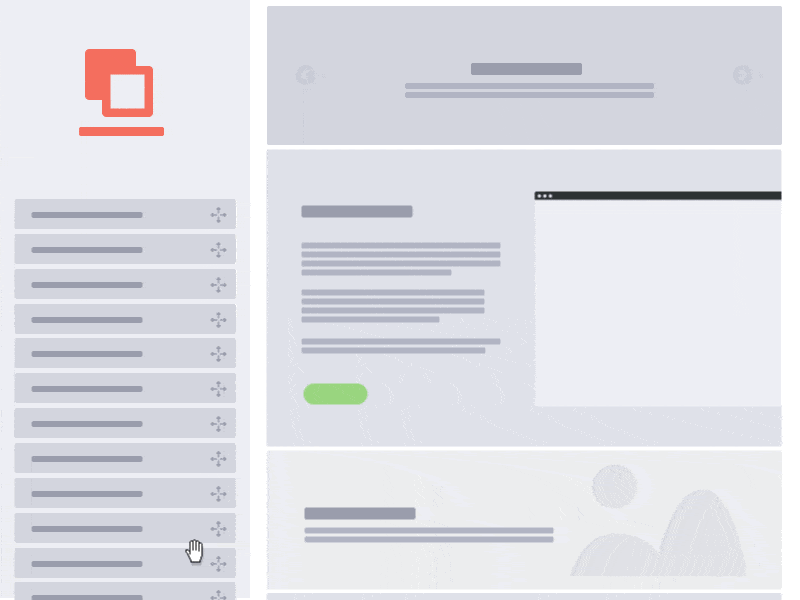Customer Experience Strategist
The evolution of e-commerce: putting the customer at the heart of your strategy
Customer Experience Strategist
The e-commerce market continues to grow year after year, and Canada is no exception. E-commerce has become a necessity for Canadian retailers, partly out of a need to adapt to shoppers’ needs and partly in response to the situation engendered by COVID-19.
The closure of stores’ physical locations forced business to make a strategic shift, focusing their efforts on remote points of sale. This Forbes article explains how stores using Shopify have been able to replace 94% of their in-store sales with online sales.
Moreover, we spoke to you about the growth of e-commerce at the outset of the pandemic. This growth has (or should, if it hasn’t already) driven e-commerce to the centre of marketing strategies, since it’s now the only (or nearly the only) customer point of contact capable of generating revenue.
More than six months after the introduction of the first health measures, which I understand to mean the lockdown and closure of physical stores, eMarketer is anticipating a deceleration of retail sales in general, but also of online sales. The pre-pandemic forecast of $4,105 trillion in e-commerce sales has now been reduced to $3,914 trillion, representing a drop of nearly $191 trillion. While it’s true that the sales channel has been saturated (think of how long it’s taken for parcels to be delivered to your door), the economic situation also needs to be taken into consideration. Households have had to prioritize certain types of expenses and revisit their spending habits, as noted by Statistics Canada. Additionally, sustainability matters more than ever to consumers, who are turning towards more responsible, more local consumption.
As you can see, in today’s world we have to learn to adapt if we want to accommodate our customers, their new habits, new behaviours, as well as their new expectations from brands. The fourth quarter of the year has just begun, often the most important quarter of the year for sales between Black Friday, Cyber Monday and the holidays.
There’s no use jumping into major digital projects right now. Instead let’s look at how you can focus your efforts on optimizing your online store.
The goal is to ensure your visitors have a positive digital experience, thereby increasing your conversion rate, with minimal effort. We will also look at what trends you should adopt to create an innovative, enjoyable customer experience. Remember, innovation is the driving force behind customer experience: from brand perception to brand loyalty.
Optimizing your e-commerce site
We strongly believe that an optimization approach will allow you to better spend your marketing budget to drive more performance. Today, digital ad costs represent a significant part of the budget. I won’t go on about the importance of targeting the right audiences and having a media strategy, since my colleagues have already done that. Instead we’ll look at how collaboration between digital advertising and targeted optimization can take you a long way.
Essentially, this work consists, first of all, of concentrating on paid traffic and where it comes from. If you can improve this, then statistically conversions will be higher, which means higher revenue and therefore a better quality ROAS. That’s why you should never neglect the CX aspect of your digital strategy, and focus on allocating your budget efficiently. For example, if your goal is to increase revenue by X%, it doesn’t make sense to buy more ads to drive more visits. Instead the metric you focus on should be your conversion rate. By increasing the conversion rate by just 0.1%, your revenue will grow – without investing more money in media placements. It’s not always enough to attract more people to your platform, sometimes it pays more to focus your attention on converting those who are already there.
Of course, optimization isn’t limited to traffic acquired through paid campaigns, it applies to all your sessions. Your approach can be generic (all sessions) or segmented, based on a variety of dimensions such as acquisition source, type of device, localization, etc. It all depends on your goals and situation.
How does it work? It’s simple, it all rests on your insights. Essentially, your optimization activities are based on data, which echoes your goals. Going back to our example of the revenue increase, we would want to analyze the user journey (either globally or by segment) to figure out the barriers to purchase. Other methodologies can also help us understand why visitors buy your products; these insights are equally useful when it comes to the optimization process.
As I mentioned, we use whatever data is available, between Google Analytics, heat maps and session recordings (Hotjar), keywords used, etc. This raw data is then deepened and transformed into insights that can be used to come up with optimizations and hypotheses.
At this point it’s easy to put the optimization in place, along with A/B testing to measure the real impact your changes have.

Though testing is encouraged, it’s not required, particularly for optimizations that have already proven themselves, or that follow best practices for digital or those laid out by other UX/CX studies.
It’s worth taking a moment to list out a few optimizations you can put in place with very little effort (labour or cost) and that, we hope, can help you in your fourth quarter.
Specific front-end modifications
- Graphic modifications: changes to your site’s CSS can have a positive impact, and can be done with extensions like CSS Hero or page builders like Elementor. Changes can be made to the size of elements, colours, shapes, fonts, etc.
- Integration of micro-interactions or animations within your site: interactions are effective, as they give the user feedback about their actions and contribute to a positive experience on the site. The most common of these are hover animations, indication that you’ve reached the end of a horizontal scroll, the activation of a CTA, loading, etc.
- Hierarchy of calls to action: depending on your goals, it makes sense to rank your CTAs. Essentially, your main CTAs should be the most easily identifiable by the user through shape or colour. Primary CTAs reflect the actions you most want users to take, like adding an item to a shopping cart or checking out.
- Think about accessibility: accessibility standards are numerous and earning an A+ for conformity throughout your site is nearly impossible, so it makes sense to prioritize. Do an assessment of the most important pages of your site to begin with (product pages, checkout) using an evaluation tool like WCAG contrast checker for contrast and font size. The minimum contrast ratio to meet standards is 4.5:1. This ratio goes down if your font is larger, either 18pt or 14pt in bold.
Page restructuring
- Information hierarchy: using insights, it’s possible to modify the elements on a page without modifying the entire site. Like with Lego blocks, you can adjust the position of information by moving blocks around to adapt the page to users’ needs.

- Adding basic functionalities: some are musts for e-commerce. You can integrate functionalities using pre-existing modules like the ones to save a shopping cart through Shopify, Prestashop and others. If no module exists, you can evaluate how relevant the functionality is given the needs of your visitors.
- Reworking content: you can improve the quality or relevance of your visuals, and you can update textual information to be more specific, and also optimize organic search.
Optimize for mobile
The use of mobile for online shopping is growing endlessly. In 2019, Statistica estimated that by the end of 2021, 73% of online sales would be completed on a mobile device. We start our research on our mobile phones (whether or not we set out with the intention to buy) because these devices are at the tips of our fingers at all times. What’s more, to optimize the performance of paid traffic the key thing, at least in my opinion, is to have a mobile-first site (or at least a mobile-first buyer’s journey). Essentially, the greatest share of your traffic by device, for paid social acquisition sources, is mainly mobile.
- Streamline your content: limited screen sizes mean you need to simplify your layout, removing anything that isn’t absolutely necessary for the user. A small header lets you leave room for what’s really important for your visitors (menu and shopping cart), you can integrate content into closed accordion menus to create space in product files, and horizontal scrolling is very big right now and allows you to gain back vertical space on the page.
- Adapt touch targets: calls to action should be a minimum of 44px high to facilitate interactions
- Font size: to maximize readability, we recommend a minimum font size of 12 points for paragraph copy to reduce eye strain and cognitive load. A word of advice, when picking your fonts, avoid going in for choices that prioritize design over information processing.
- Make search easy: with the menu being 99% a hamburger menu, placing the search bar in a prominent location allows visitors to easily orient themselves.
E-commerce trends
As you can imagine, it’s becoming difficult to predict what the next big thing in e-commerce will be. The trends announced at the beginning of 2020 are no longer priorities for companies, who now need to focus on flexibility to be able to change direction at any moment. It has now become essential to have a strong omnichannel strategy for an integrated customer experience.
That said, let’s take a look at what larger changes you can make to improve your customer experience.
Augmented reality
This technology allows you to reduce ambiguity about products by allowing the user to see the product in a real-world environment. Popular in the optical field, augmented reality gives you the opportunity to try on glasses from your living room. And talking about living rooms, you can also see what a new sofa might look like in your space before you buy, using the Ikea app.
Other brands and industries are using augmented reality for their products, for example Lancôme cosmetics (yes, I tried on lipstick from my desk while writing these words). This functionality plays on our emotions, on the “nearly tangible” by partially if abstractly traversing the limits of the tactile aspects of the product, right before you click “add to cart.” In the time of COVID, how else can you try on lipstick, if not with augmented reality?
Video as product visual
Since augmented reality isn’t within everyone’s reach, the alternative is still a video showing the product from all angles, in action and describing the characteristics of the product. Asos and other brands have incorporated product videos on their site for years. The presence of video on product pages increases user engagement and influences purchase decisions by limiting the risk of disappointment and product returns. A further advantage is that video can increase your visibility in search results (certain requirements obviously need to be followed).
The use of chatbots
This automated messaging service that provides customers with rapid responses to frequently asked questions is becoming more and more popular. However, the functionalities of a chatbot almost need their own communication and activation strategy. Far more than pat answers and rapid response times, chatbots use artificial intelligence and could become real substitutes for physical salespeople. This technology is also a way to communicate with large numbers of visitors while making each person feel that they are receiving personalized attention. Through keyword recognition, chatbots are able to redirect customers to the right page, provide product suggestions and even finalize purchases. Some chatbots will also allow you to stay in contact and send follow-ups in Facebook Messenger.
Artificial intelligence and personalization
Using user data, you can adapt your site based on the needs of your visitors. This requires a culture of data and real-time data processing. A study revealed that personalized experiences on a site or in a marketing initiative lead to a 25% increase in revenue.
Ethical and sustainable trade
Sustainability is taking on renewed importance for modern shoppers who are becoming increasingly aware of the role their purchasing choices play on the Earth’s resources. An enquiry revealed that 50% of respondents were looking for more sustainability in the fashion industry and 75% wanted to see less packaging. What’s more, buying local is now front and centre, since many people are trying to support local economies during the pandemic.
Brands that improve their operations to benefit the environment, for example by switching to biodegradable packaging, sourcing fair trade products, and reducing plastic, cardboard and paper in shipments will have a significant advantage when it comes to buyers’ purchase choices.
As you can see, to stay on top of changes and adapt to any situation, having an online store is becoming essential, and a necessary part of a retailer’s omnichannel strategy.
Online stores are a veritable playground for CRO (Conversion Rate Optimization), which can allow you to make changes that will bring real value to your business. Decisions are made based on insights, then tested on a large volume of traffic. By continually working on your customer experience, your buyer’s journey and offering innovative services, you can achieve your business goals while spending less on digital advertising (assuming you already have high-quality targeting in place).
Between rapid optimization and innovative projects, e-commerce is still evolving and reinventing itself based on consumer habits. It’s essential to put your customer at the heart of your decisions and actions if you want to meet their needs and be innovative.







